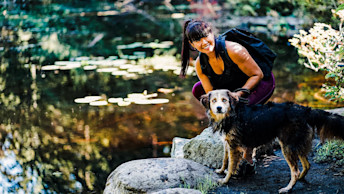September 24, 2021
First Aid Tips for Your Dog

Dogs sometimes have a mind of their own and this gets them into trouble.
When your dog encounters a problem, like eating something they shouldn't or an illness, are you confident in dog first aid?
Even though curiosity may kill the cat, curiosity in a dog sometimes requires you to think quickly and act appropriately to avoid further medical problems. Here are some tips and tricks you need to help your dog in case of an emergency.
What is a Dog First Aid Kit?
A dog first aid kit has items needed in case you and your dog faces an emergency. It's similar to a human first aid kit, with medical supplies to contain an emergency if it arises.
Here are some supplies you might find in a dog's first aid kit:
- Gloves
- Gauze or cotton balls
- Scissors for snipping away hair and cutting bandages
- Flashlight
- Tape for gauze
- Hydrocortisone cream
- Hydrogen peroxide
- Antibiotics for dogs like a spray
- Extra water
- Splints
- Ice and hot pack
- Muzzle or leash to hold your dog still
- Phone numbers of veterinarian
- Medical records
- Protective eye gear for yourself
- Thermometer
- Tweezers
- Milk of Magnesia
- Towels
- Dropper or bulb syringe
- Any medications your dog takes
These are some of the most necessary items you'll need. You can purchase most of these items at your local drug store and store them in a container, bag, or backpack.
When Should You Use the First Aid Kit?
Sometimes it's hard to know whether or not your dog is in an actual emergency and when to pull out the dog first aid kit. Most pet emergencies happen when you're not at home. What are the signs you need to look for?
Here are some ways you can tell if you need the first aid kit.
If your dog is bleeding or burned, you'll need to stop the bleeding and possibly remove any foreign objects if you can. Use this by applying pressure to the wound and bandaging it up. Never use adhesive bandages on the dog because it will damage their skin and fur.
If you notice your dog acting woozy or delirious from the heat while on a walk or a run, move to a shaded area or indoor space immediately. Place a cool, wet towel on your dog and keep them cool for as long as you can.
Dogs are notorious for eating things they shouldn't and as a result, they could become poisoned. If you're out and you believe your dog has injected poison, administer Milk of Magnesia or hydrogen peroxide and then call the vet.
You know your dog better than anyone else, and if they're acting out of the ordinary, you want to know what's up. If you're out, you can take their temperature to see if they have a fever or other illness.
Dogs choking is a common occurrence, since they eat strange objects sometimes. If your dog is choking, look inside your dog's mouth, carefully, and try to remove the object with tweezers or your fingers without pushing it farther in. If your dog collapsed, squeeze their ribs gently but firmly to force air to propel the object out of their mouth.
Tending to an emergency with a first aid kit is only the beginning of making sure your dog is treated before problems become larger. Your dog should be seen by a veterinarian as soon as you're able to ensure there are no additional problems and that they're recovering well. Be sure to follow the post-visit directions exactly.
Handling an Injured Dog
Seeing your dog in pain or danger may provoke several different emotions, but you must remain calm so you can help your pet. Here are some tips for how to handle injured dogs.
Always muzzle your pet. Dogs become confused and scared when they're hurt and they may lash out causing more injury to themselves or you. Before you begin any treatment, place a properly fitted muzzle on your dog.
Observe the wound or problem and take action by looking in your dog kit for the proper supplies. Use gauze and tape for bleeding, splints for broken bones, and so forth. You must remain calm so you can think and act properly.
Make sure your pet stays as comfortable as possible, so use blankets if necessary to keep them down and secure. Sometimes blankets work as stabilizers if your dog is particularly prone to fits during treatment.
Once you've addressed the injury or incident properly, you can call your vet, explain the situation, and take your dog to be seen. Some vets offer pet ambulances, ask about those services at your next vet visit.
When to Call Emergency Services
There are times when you cannot handle an emergency with a first aid kit and your dog will need immediate medical attention.
Here are some instances where you need to reach a vet:
- Your dog is not breathing
- Your dog's heart stopped beating
- Difficulty breathing
- Had a seizure
- Unresponsive or lethargic, meaning they will not move at all
- Seem disoriented with no visible reason
If you're ever unsure or feel unable to treat your pet, always practice caution and get them to a vet.
Protect Your Pup
The best dog first aid kit will contain several things to give you peace of mind when treating your dog. Once you know and understand how to use the dog's first aid kit, you can feel confident that your dog will be treated well before seeing a vet.
Helping your pet recover from injury means feeding them the right pet food with the right nutrients! Discover more about how to keep your pet healthy with the best pet food!


